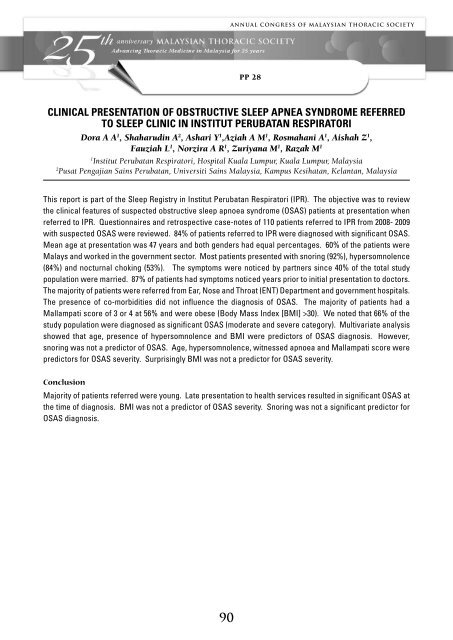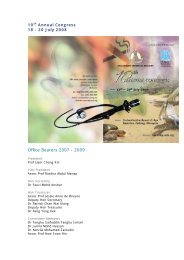download - Malaysian Thoracic Society
download - Malaysian Thoracic Society
download - Malaysian Thoracic Society
You also want an ePaper? Increase the reach of your titles
YUMPU automatically turns print PDFs into web optimized ePapers that Google loves.
Annual Congress of <strong>Malaysian</strong> <strong>Thoracic</strong> <strong>Society</strong><br />
PP 28<br />
Clinical Presentation of Obstructive Sleep Apnea Syndrome Referred<br />
to Sleep Clinic in Institut Perubatan Respiratori<br />
Dora A A 1 , Shaharudin A 2 , Ashari Y 1 ,Aziah A M 1 , Rosmahani A 1 , Aishah Z 1 ,<br />
Fauziah L 1 , Norzira A R 1 , Zuriyana M 1 , Razak M 1<br />
1<br />
Institut Perubatan Respiratori, Hospital Kuala Lumpur, Kuala Lumpur, Malaysia<br />
2<br />
Pusat Pengajian Sains Perubatan, Universiti Sains Malaysia, Kampus Kesihatan, Kelantan, Malaysia<br />
This report is part of the Sleep Registry in Institut Perubatan Respiratori (IPR). The objective was to review<br />
the clinical features of suspected obstructive sleep apnoea syndrome (OSAS) patients at presentation when<br />
referred to IPR. Questionnaires and retrospective case-notes of 110 patients referred to IPR from 2008- 2009<br />
with suspected OSAS were reviewed. 84% of patients referred to IPR were diagnosed with significant OSAS.<br />
Mean age at presentation was 47 years and both genders had equal percentages. 60% of the patients were<br />
Malays and worked in the government sector. Most patients presented with snoring (92%), hypersomnolence<br />
(84%) and nocturnal choking (53%). The symptoms were noticed by partners since 40% of the total study<br />
population were married. 87% of patients had symptoms noticed years prior to initial presentation to doctors.<br />
The majority of patients were referred from Ear, Nose and Throat (ENT) Department and government hospitals.<br />
The presence of co-morbidities did not influence the diagnosis of OSAS. The majority of patients had a<br />
Mallampati score of 3 or 4 at 56% and were obese (Body Mass Index [BMI] >30). We noted that 66% of the<br />
study population were diagnosed as significant OSAS (moderate and severe category). Multivariate analysis<br />
showed that age, presence of hypersomnolence and BMI were predictors of OSAS diagnosis. However,<br />
snoring was not a predictor of OSAS. Age, hypersomnolence, witnessed apnoea and Mallampati score were<br />
predictors for OSAS severity. Surprisingly BMI was not a predictor for OSAS severity.<br />
Conclusion<br />
Majority of patients referred were young. Late presentation to health services resulted in significant OSAS at<br />
the time of diagnosis. BMI was not a predictor of OSAS severity. Snoring was not a significant predictor for<br />
OSAS diagnosis.<br />
90








